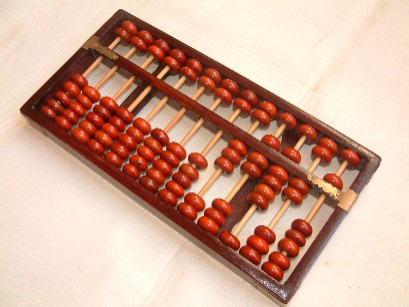Difference between revisions of "Activities/Abacus"
Jump to navigation
Jump to search
| Line 10: | Line 10: | ||
| − | [http://en.wikipedia.org/wiki/Abacus Abacus] lets the learner explore different representations of numbers using different mechanical counting systems developed by the ancient Romans and Chinese. There are several different variants available for exploration: a [http://en.wikipedia.org/wiki/Suanpan suanpan], the traditional Chinese abacus with 2 beads on top and 5 beads below; a [http://en.wikipedia.org/wiki/Soroban soroban], the traditional Japanese abacus with 1 bead on top and 4 beads below; | + | [http://en.wikipedia.org/wiki/Abacus Abacus] lets the learner explore different representations of numbers using different mechanical counting systems developed by the ancient Romans and Chinese. There are several different variants available for exploration: a [http://en.wikipedia.org/wiki/Suanpan suanpan], the traditional Chinese abacus with 2 beads on top and 5 beads below; a [http://en.wikipedia.org/wiki/Soroban soroban], the traditional Japanese abacus with 1 bead on top and 4 beads below; the [http://en.wikipedia.org/wiki/Abacus#Russian_abacus schety], the traditional Russian abacus, with 10 beads per column, with the exception of one column with just 4 beads used for counting in fourths; and the [http://en.wikipedia.org/wiki/Abacus#Native_American_abaci Nepohualtzintzin], a Mayan abacus, 3 beads on top and 4 beads below (base 20). |
<gallery> | <gallery> | ||
| Line 20: | Line 20: | ||
</gallery> | </gallery> | ||
| − | |||
| − | |||
| − | |||
| − | |||
[[Category:Activities]] | [[Category:Activities]] | ||
Revision as of 08:08, 3 April 2010
Where to get Abacus
About Abacus
Abacus lets the learner explore different representations of numbers using different mechanical counting systems developed by the ancient Romans and Chinese. There are several different variants available for exploration: a suanpan, the traditional Chinese abacus with 2 beads on top and 5 beads below; a soroban, the traditional Japanese abacus with 1 bead on top and 4 beads below; the schety, the traditional Russian abacus, with 10 beads per column, with the exception of one column with just 4 beads used for counting in fourths; and the Nepohualtzintzin, a Mayan abacus, 3 beads on top and 4 beads below (base 20).




